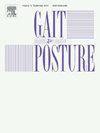Vision-based postural balance assessment of sit-to-stand transitions performed by younger and older adults
IF 2.2
3区 医学
Q3 NEUROSCIENCES
引用次数: 0
Abstract
Background
The use of inertial measurement units (IMUs) in assessing fall risk is often limited by subject discomfort and challenges in data interpretation. Additionally, there is a scarcity of research on attitude estimation features. To address these issues, we explored novel features and representation methods in the context of sit-to-stand transitions. This study recorded sit-to-stand transition test data from three groups: community-dwelling elderly, elderly in day care centers (DCC), and college students, captured using mobile phone cameras.
Method
We employed pose estimation technology to extract key point kinematic features from the video data and used 10-fold cross-validation to train a random forest classifier, mitigating the impact of individual differences. We trained classifiers with the top 5, 10, and 15 features, calculating the average area under the receiver operating characteristic curve (AUC) for each model to compare feature importance.
Results
Our results indicated that elbow key point features, such as (KP08) mean Y, (KP08)RMS Y, (KP09) mean Y, and (KP09) RMS Y, are crucial for distinguishing between subject groups. Statistical tests further validated the significance of these features. The application of human pose estimation and key point signals shows promise for clinical postural balance screening. The identified features can be utilized to develop non-invasive tools for assessing postural instability risk, contributing to fall prevention efforts.
Conclusion
This study lays the groundwork for integrating additional measurement modalities into sit-to-stand transition analysis to enhance clinical strategies.
对年轻人和老年人从坐到站的转变进行基于视觉的姿势平衡评估。
背景:惯性测量单元(imu)在评估跌倒风险时经常受到受试者不适和数据解释方面的挑战的限制。此外,对姿态估计特征的研究也很少。为了解决这些问题,我们探索了坐姿到站立转换的新特征和表现方法。这项研究记录了三组人群的坐姿到站立的转换测试数据:社区居住的老年人、日托中心的老年人和大学生,这些数据是用手机相机拍摄的。方法:采用姿态估计技术从视频数据中提取关键点运动特征,并采用10倍交叉验证训练随机森林分类器,减轻个体差异的影响。我们使用前5、10和15个特征训练分类器,计算每个模型的接收者工作特征曲线(AUC)下的平均面积,以比较特征的重要性。结果:肘关节关键点特征(KP08) mean Y、(KP08)RMS Y、(KP09) mean Y和(KP09) RMS Y)是区分受试者群体的关键特征。统计检验进一步验证了这些特征的显著性。人体姿态估计和关键点信号的应用为临床姿势平衡筛查提供了前景。识别出的特征可用于开发非侵入性工具来评估姿势不稳定风险,有助于预防跌倒。结论:本研究为将额外的测量方式整合到坐姿到站立的转变分析中,以提高临床策略奠定了基础。
本文章由计算机程序翻译,如有差异,请以英文原文为准。
求助全文
约1分钟内获得全文
求助全文
来源期刊

Gait & posture
医学-神经科学
CiteScore
4.70
自引率
12.50%
发文量
616
审稿时长
6 months
期刊介绍:
Gait & Posture is a vehicle for the publication of up-to-date basic and clinical research on all aspects of locomotion and balance.
The topics covered include: Techniques for the measurement of gait and posture, and the standardization of results presentation; Studies of normal and pathological gait; Treatment of gait and postural abnormalities; Biomechanical and theoretical approaches to gait and posture; Mathematical models of joint and muscle mechanics; Neurological and musculoskeletal function in gait and posture; The evolution of upright posture and bipedal locomotion; Adaptations of carrying loads, walking on uneven surfaces, climbing stairs etc; spinal biomechanics only if they are directly related to gait and/or posture and are of general interest to our readers; The effect of aging and development on gait and posture; Psychological and cultural aspects of gait; Patient education.
 求助内容:
求助内容: 应助结果提醒方式:
应助结果提醒方式:


